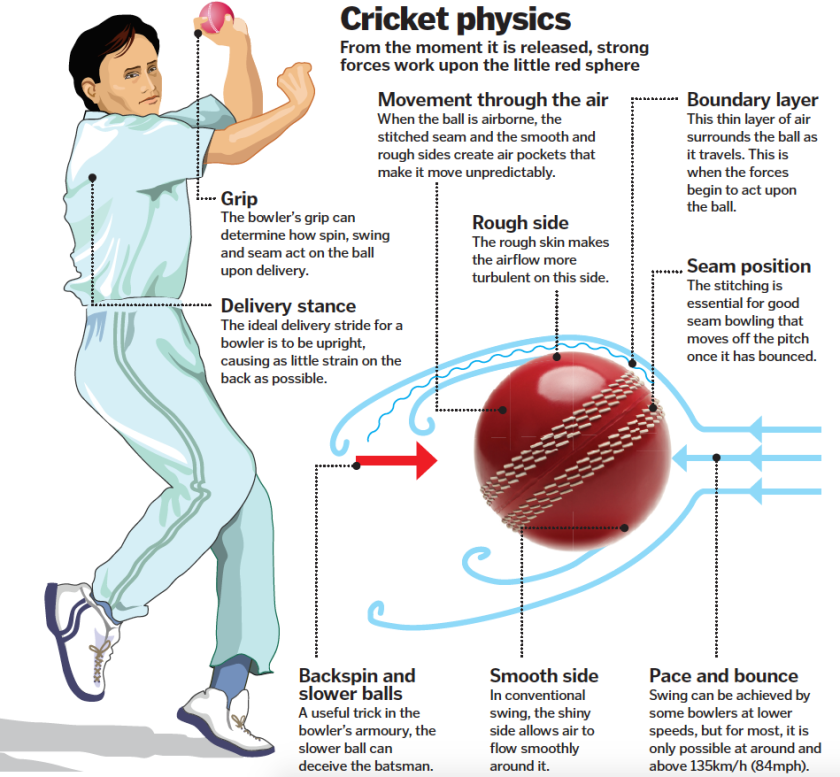When I used to play cricket in the backyard with my brother we would try all sorts of things to make it harder to bat. We both were batters. We couldn’t use a cricket ball because the ball slamming into the window behind the stumps was already loud and bad enough, my dad’s frequent yelling testament to that. To improvise, we decided to try make our tennis ball more like a cricket ball, and put masking tape around its centre to act as a seam – like on a cricket ball. Possibly by mistake, or maybe with somebody’s advice, we realised that if we covered one side of the ball completely in tape, the ball would swing quite wildly when bowled, causing the batsmen all sorts of difficulty.

This was a revelation. Depending on how you held the ball, you could make it move either towards the batsmen, or away from him/her (my poor much younger sister didn’t stand a chance). If you held the ball upright (along the seam), if the covered side was facing to the right, the ball would swing inwards towards the batter, and if the covered side was on the left, the ball would swing away. And then we realised, that the more tape you put on it, the more radical the movement. This was so much fun. You could aim the ball quite a distance from where it would end up. It really improved my batting, because you had to really pay attention, and react quickly. The only downside was the tape would eventually keep coming off when the batsmen hit it – so annoying having to continually re-tape the ball.

The key though was to keep holding the ball differently to vary the amount of swing, otherwise the batter would anticipate the movement every time. I think the physics of it all is that the covered side, being much smoother than the rougher uncovered side, would move through the air faster causing the ball to lean one way or the other. The same principle applies to the cricket ball, which is why you’ll see players furiously rubbing the ball on their trousers, and not as my cynical first girlfriend said, to get their jollies. They are trying to make one side shinier than the other. But getting the same degree of movement is infinitely harder with a real cricket ball, and as a young cricketer I simply couldn’t emulate the swing.

At no point was I ever taught how to swing the ball in cricket. Despite the fact that I was an avid cricketer, albeit as a batter, and quite successful too, making a First 11 hundred, and invited to play for an A-grade club in South Australia, no one took me aside and gave me explicit training in how to make that damn ball swing. I must have bowled thousands upon thousands of balls in the nets too. Yes, I tried to copy what I was doing in the backyard, but it didn’t seem to translate, and so I didn’t continue the line of inquiry. What I needed was an expert to show me how to hold the ball better, that each slight adjustment made a big difference, to keep correcting me till I got it mastered, to make me practice again and again a particular grip, all the while explaining to me why each error was an error. Needless to say, I never made it as a successful bowler. In fact, if I ever was used as one of those ‘let’s try this as a last resort’ type bowler, like Joe Root (😉), I was punished quite mercilessly by the grinning and wide eyed batsmen.
This is a lot like teaching. All students have the potential to learn what we are teaching them. But if we don’t teach students bit by bit in an incremental approach, diligently and assiduously model thinking and writing, give them time to practice again and again until they achieve mastery, ascertain where a student is on the learning path, give precise feedback and help them realise why things are happening, they will miss opportunities to develop and strengthen particular knowledge and skill. Yes, some will stumble onto a discovery and run with it; some bowlers did emulate their backyard knowledge on their own. But many won’t, and I don’t want to play those odds with my students.

I’m Paul Moss. Follow me on Twitter @edmerger, and follow this blog for more educational and English teaching discussions.
